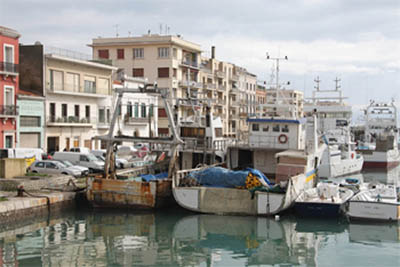
The Underwater Museum of Marseille: Don’t Forget Your Goggles
By Megan Mentuck
The Underwater Museum of Marseille offers visitors a unique experience to observe and consider art… underwater!

Located 100 meters offshore from Catalans Beach in France, this strange art exhibition requires a pair of goggles.
The Underwater Museum of Marseille presents visitors with ten sculptures submerged at a depth of five meters to explore.
GoNOMAD spoke with Antony Lacanaud, a representative from the Underwater Museum of Marseille, to learn more about the unique art exhibition space.
Five Core Missions: Art, Science, Education & Sustainability!
The museum has five core missions driving its purpose beneath the surface. The first being participation in education and the sharing of knowledge.
This means that the museum is committed to planning educational events, community outreach, and other means of encouraging visitors to come to visit and most importantly, learn something new.

The next core mission of the museum is to monitor scientific developments and contribute knowledge of the marine environment that it is set in.
In order to achieve this goal, The Underwater Museum of Marseille is a site for studying the underwater Mediterranean biosphere.
Another core mission of The Underwater Museum of Marseille is stimulating curiosity and openness to the world. This means meeting the expectations of educational tools and using creativity to provide opportunities for a diverse audience.
The fourth core goal is to make art and science accessible to everyone while the last core mission is to drive sustainability.
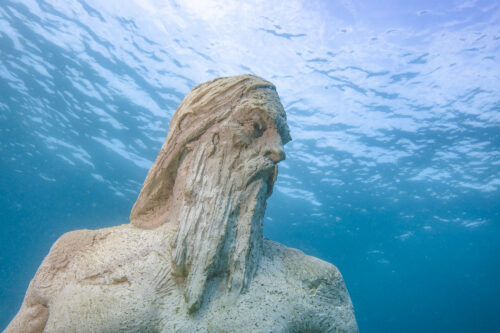
By combining art and science, the museum is able to encourage learning across an audience with varying interests and promote sustainability in a unique fashion.
When asked about his favorite aspect of the museum, Lacanaud shared, “The museum is a multidisciplinary portal, I like its collaborative and creative multicultural aspect.”
Ten Artists, Ten Sculptures, Ten Universes
The Underwater Museum of Marseille consists of ten different sculptures five meters or about sixteen feet underwater.
Each sculpture is created by a different artist; however, every artist shares an interest in the environment and more specifically marine environment.

The artists include: Michel Audiard, Christophe Charbonnel, Benoit De Souza, Davide Galbiati, Evelyne Galinski, Herrel, Marc Petit, Sovereign Mathias, Thierry Trives, and Daniel Zanca.
Each artist provides a unique sculpture that reflects their own artistic style as well as an appreciation for their marine environment.
The sculptures represent a host of different things, including animals, people, and even trees. One sculpture, “The Bear tribute to Pompon” by Michel Audiard places a bear underwater, a stark reminder of the melting ice caps and the danger that this manmade phenomenon poses to habitats in the natural world.
“Co-existence” by Herrel is another sculpture included in the Underwater Museum of Marseille. It offers a more abstract representation of the disconnect between nature and our modern world.
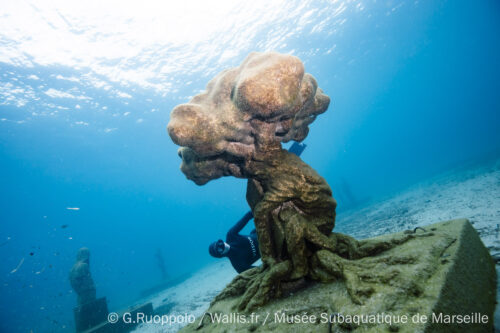
The sculpture appears to represent a building being swallowed by the roots of a tree. Above this representation, there is a tree canopy meant to resemble a naturally occurring marine plant when it’s underwater. The canopy is also specially designed to allow aquatic fauna to grow there.
All of the sculptures are created using recycled marine cement with a neutral pH, making them environmentally friendly. The whole collection of sculptures together also work to create an artificial reef that acts as a home for marine animals local to the region.
Lacanaud spoke to the collective aspect of the museum saying, “The museum functions as a jazz band with autonomous, creative and complementary individuals, listening to each other to constantly ensure balance, energy and perfect achievement for the whole.”
The Friends of the Museum Association
Thanks to the association of the Underwater Museum of Marseille, the site of the museum is constantly maintained for visitors.
The association monitors the site and works to generate awareness of its existence while also monitoring its environmental and socio-economic impacts.
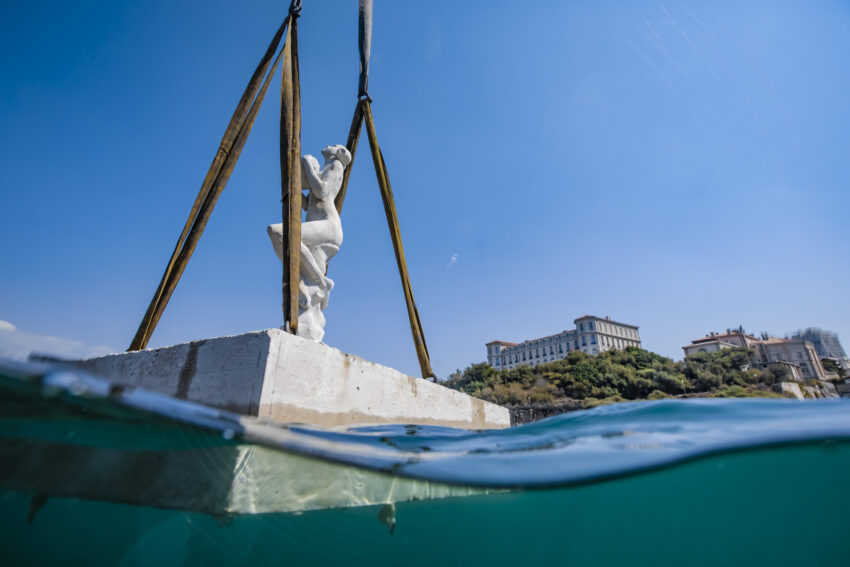
Plan Your Visit
If your interests are in art, marine biology, environmental sciences, or some combination of those, a trip to the Underwater Museum of Marseille should definitely be added to your travel itinerary.
Before you arrive on-site, there are some things that you should know beforehand. For example, you should be able to swim 200 meters—100 meters to the underwater museum and 100 meters back to shore.
Once you get to the site, you can rest on a swim buoy that is provided above the sculptures. You should also bring the necessary equipment: a swim mask or goggles, a snorkel, and fins. The swim mask or goggles is absolutely necessary in order to see the art!
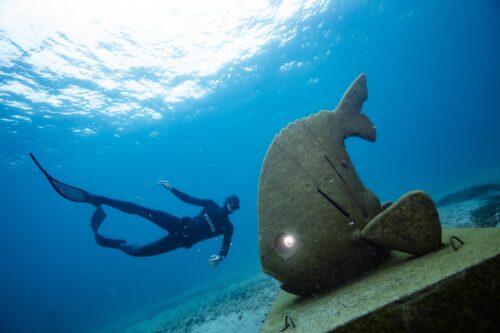
For safety reasons, guests should notify someone on shore that they are visiting the museum before they go.
Once you follow the necessary steps and get to the art, it’s important not to touch the sculptures or any marine life that may be occupying the area.
However, visitors are encouraged to keep the site clean by picking up any trash that may be lurking under the water.
Group Tours
If you’re interested in visiting the museum with an expert on the art, there are opportunities for guided tours to the site as well.
You can scuba dive to the site with a tour guide by finding a time slot that works best for you on their website.
No matter who you are, a trip to the Underwater Museum of Marseille will definitely be an eye-opening experience.
Lacanaud said, “Discovering sculptures in this underwater context will be a fantastic experience and souvenir. The sculptures are already colonized by microorganisms. So take your masks and dive!”
Eurail Passes: What to Know about Buying a Europe Train Pass
- Airport Expansion: Hong Kong Set to Spend $18 Billion - June 26, 2023
- Visit the Stunning City of Berlin This Year - January 3, 2022
- Brattleboro Vermont: Arts Oasis - July 15, 2021


